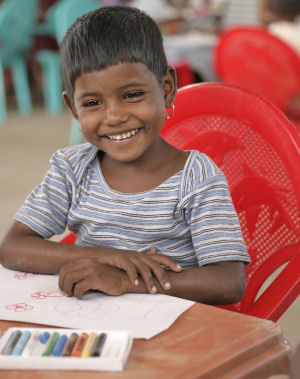Tsunami One Year on: Re-establishing trust
28/12/2005

Re-establishing trust
How children in Sri Lanka come to terms with their traumatic experiences
It is actually difficult to imagine what coping strategies children need to overcome the shock of the tsunami disaster. A first-hand account by local SOS volunteers, teachers and educational experts in Komari, on the East coast of Sri Lanka, illustrates this meticulous process.
In view of the urgent need to provide children with psychological support following the tsunami disaster, SOS Children established activity centres offering various programmes aimed at trauma relief in the small village of Komari. Classes were also arranged, as the children would have otherwise gone for months without any schooling. Both the parents and children were very shocked after their experiences on 26 December 2004, and constantly feared another tsunami. Since the school is close to the sea and relatively far from their homes, parents did not wish to send children to school, as they would be "out of reach". The activity centres met both their therapeutic and educational needs.
In order to give the children a feeling of stability, order and safety in the midst of chaos, local volunteers regularly taught and ran activity programmes for primary school children in the mornings, and in the afternoons, other age groups were taught. Volunteers from other organisations also assisted severely traumatised children at the SOS Centres. The local SOS volunteers said that the children could not be approached at all in the beginning, "They had images in their minds that they could not place, not even in their wildest dreams."
One of the first therapeutic measures was to have them paint pictures. The children used dark, aggressive colours, such as red, dark green and black. The pictures were of people, land and trees, all under water. In the beginning they only went to the lessons sporadically, and it took a long time for signs of healing to be visible. Some children spoke about what they had experienced, but most would not talk to the helpers; some could not even look them in the eyes.
There were moments when the children did not react to questions being asked and could not concentrate: "They would just be gone, lost in their thoughts", explains one of the staff about the difficult first phase. The local SOS volunteers needed support themselves in order to cope with the situation and to show the children a way out of their inner paralysis. Experts helped them and through time, the children began to regain their trust. They started speaking more openly, showed their pictures, and it was possible to converse with them. Cheerfully-coloured toys helped them improve their concentration, and theatrical and interactive games were used to make contact with children who could or would not speak. Children who had extremely difficult situations to recover from were counselled individually. This work was mentally very demanding for the volunteers and staff. But after considerable efforts, it has been possible to ease the children’s trauma and most of them now attend class regularly.
Are the children able to look at the sea impartially almost a year after the disaster? "Not always, because they know that the ocean can create absolute chaos, and repeated tsunami alarms bring back all the memories", says an employee of SOS Children's Villages in Sri Lanka. "But these children are also witness to and are affected by an ethnic war which has marked their lives for years. You can see them playing on the beach and going to class again now; they try to adapt their daily lives to the changes over which they have no control."
This article is part of the tsunami one year on review.
Relevant Countries: Sri Lanka.